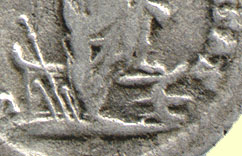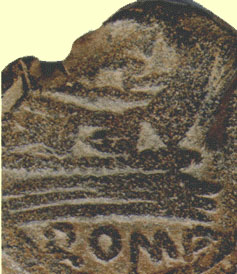 Contents -
Previous Article -
Next Article
Contents -
Previous Article -
Next Article
Ship's Prow (ROSTRUM)
It was the ancient custom for Roman senators and victorious generals to give speeches from the captured prows, or bows of enemy ships. The ships would be drawn up on the beach and destroyed except for the prow. From time to time, a captured prow graced the Forum in Rome and men would stand upon it to give an inspiring (or perhaps boring!) oration. Our English word rostrum, meaning a wooden stand behind which a speaker stands and on which the written speech is placed comes from the Latin word for ship's prow. The presence of the prow on a coin reverse may be used to signify victory, the importance of the grain supply (which was carried from Egypt in ships) or an emperor's care in ensuring an adequate grain supply. The ship's prow was also used in many messages of a patriotic character.
The image at the top of the page is from the reverse of a denarius of Julia Domna. A warship's prow can clearly be seen to the right, with the rudder used to steer the ship on the left. Romans liked using mautical symbols on their coins much more than they enjoyed living the actual life of a sailor. Unlike the Greeks, the Romans did not use the sea any more than was absolutely mecessary to govern their vast empire and deliver the goods they traded in commerce.  The image to the left is of the prow of a Roman warship on the reverse of a Republican as. The most prominent feature is the heavy bronze ram, shaped somewhat like a webbed metal fin with three ribs. this ram was used to crush the hulls of enemy ships during battle. The warship's commanding officer would have his men row the ship up to maximum speed and the steersman would ram the side of the enemy vessel. Usually this ripped a gaping hole in the enemy hull. The Roman seamen, more comfortable with the infantry tactics of a land army than with warfare at sea, would rush aboard and finish off any remaining enemy marines. The poor wretches caught belowdecks wereusually drowned, as few people knew how to swim in ancient times.
The image to the left is of the prow of a Roman warship on the reverse of a Republican as. The most prominent feature is the heavy bronze ram, shaped somewhat like a webbed metal fin with three ribs. this ram was used to crush the hulls of enemy ships during battle. The warship's commanding officer would have his men row the ship up to maximum speed and the steersman would ram the side of the enemy vessel. Usually this ripped a gaping hole in the enemy hull. The Roman seamen, more comfortable with the infantry tactics of a land army than with warfare at sea, would rush aboard and finish off any remaining enemy marines. The poor wretches caught belowdecks wereusually drowned, as few people knew how to swim in ancient times.
Go to next article: Simpulum
Go back to previous article: Serpent
Return to Reverse Types Table of Contents
Return to Roman Coins Table of Contents
 The image to the left is of the prow of a Roman warship on the reverse of a Republican as. The most prominent feature is the heavy bronze ram, shaped somewhat like a webbed metal fin with three ribs. this ram was used to crush the hulls of enemy ships during battle. The warship's commanding officer would have his men row the ship up to maximum speed and the steersman would ram the side of the enemy vessel. Usually this ripped a gaping hole in the enemy hull. The Roman seamen, more comfortable with the infantry tactics of a land army than with warfare at sea, would rush aboard and finish off any remaining enemy marines. The poor wretches caught belowdecks wereusually drowned, as few people knew how to swim in ancient times.
The image to the left is of the prow of a Roman warship on the reverse of a Republican as. The most prominent feature is the heavy bronze ram, shaped somewhat like a webbed metal fin with three ribs. this ram was used to crush the hulls of enemy ships during battle. The warship's commanding officer would have his men row the ship up to maximum speed and the steersman would ram the side of the enemy vessel. Usually this ripped a gaping hole in the enemy hull. The Roman seamen, more comfortable with the infantry tactics of a land army than with warfare at sea, would rush aboard and finish off any remaining enemy marines. The poor wretches caught belowdecks wereusually drowned, as few people knew how to swim in ancient times.
 Contents -
Previous Article -
Next Article
Contents -
Previous Article -
Next Article